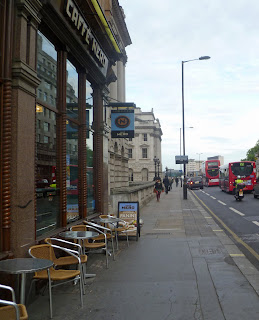Emily Kastl
Wait — we’re in Spain, so what’s all this Celtic talk? And how exactly do witches and bagpipes fit into the picture? To explain this cultural hodgepodge, let’s start with the settlements of the Celts in the land of Galicia during the 11th century. Fast-forward to present day Galician culture and you’ll find traditional Celtic influences in music (remember the bagpipes I mentioned?), festivals, holidays, and, of course, food. But what about the Galicians’ apparent obsession with witchcraft? Meigas (good witches) are thought to be the descendents of the Druids who practiced pagan rituals. When we explored towns in Galicia, we saw more witch figurines in gift shops than you can imagine, and lots of bagpipes too — but never a witch playing a bagpipe. Bummer…
Now that we have a basic understanding of culture and where it came from, let’s get down to the matter at hand: Galician gastronomy. Due to its close proximity to the Atlantic Ocean and Bay of Biscay, this region boasts some of the freshest and most delectable seafood in the world. In fact, Galicia brings in more seafood than any other region in Europe! And if you’re looking for pasta or rice, forget about it! It’s all about the potato as a side dish here. Let me give you an example of this by citing one of the best meals of my life; “Seafood Fest 2011” served as a celebration for completing our 500-mile journey and arriving in Santiago de Compostela. This aptly named dinner consisted of no less than 6 courses, all of which were of the “surf” variety. Cuddle fish cooked in its own ink? Yes please. If the thought of that makes you a little squeamish, how about fresh empanada made with tuna that was most likely swimming earlier that day? As if it couldn’t get any better, bring on scrambled eggs with shrimp and a lobster cream sauce. Heaven.
If you aren’t a fan of “surf” and “turf” is more your style, try the alternative version of Seafood Fest 2011: Meatfest 2011! After our crustacean carousal we were all ready to sample Galician-style meats. We arrived at the restaurant for lunch and were promptly served wine from bowls; I knew I liked Galicians. Before we knew it, they were bringing out vats of sizzling meats. This is not an exaggeration by any stretch. We tasted pork, sausages, ribs, and whatever else they brought out in mini charcoal grills. You’ve probably heard of the infamous “meat sweats.” If you haven’t, they occur when one consumes a sizable amount of meat and literally begins to sweat. For the first time in my life, I witnessed first-hand a man with the meat sweats. Judging by this picture, it’s easy to see why.
Though the Camino may have ended, our gastronomical exploration has not. Next time we’ll look at an average day-in-the-life of a Spanish eater. What better way to describe this than with a few personal food etiquette faux pas? ¡Buen provecho!















